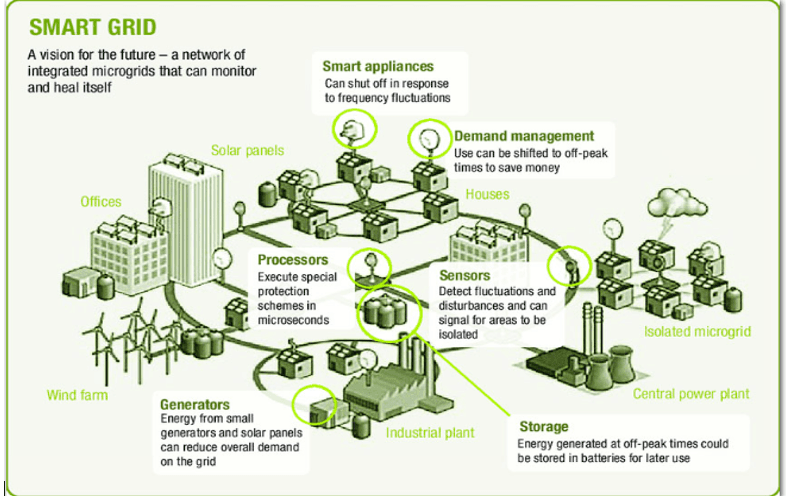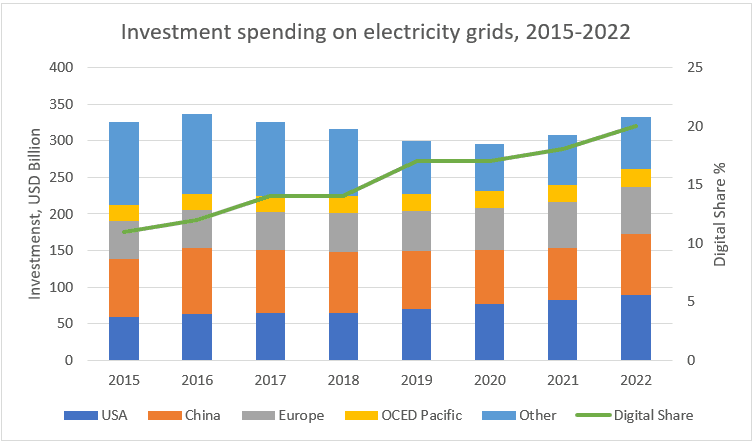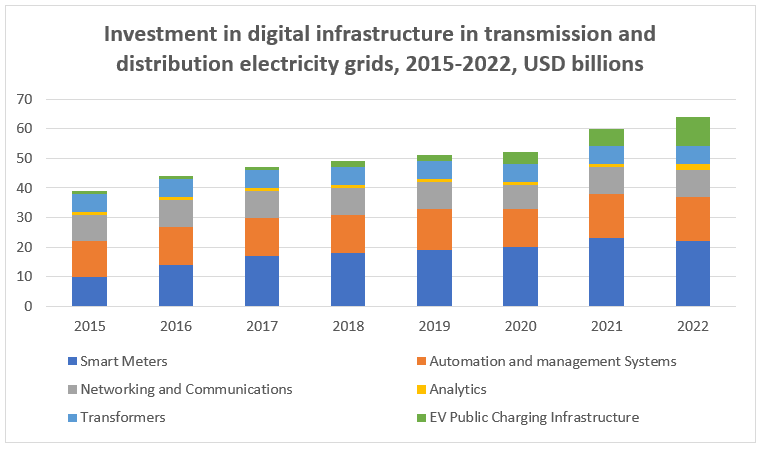Author: Vikas Kumar
19 December 2023
Introduction
The global concern over climate change has reached critical levels, prompting urgent action to mitigate its impacts and transition towards a more sustainable future. Climate change, driven by anthropogenic activities, necessitates urgent action to reduce greenhouse gas emissions and transition towards a low-carbon energy landscape. One of the key contributors to greenhouse gas emissions is the traditional energy sector, predominantly reliant on fossil fuels. As a countermeasure, the development and integration of smart grids have emerged as a promising solution. Smart grids not only enhance the efficiency and reliability of energy distribution but also play a pivotal role in addressing climate change challenges. The smart grid emerges as a transformative paradigm, offering advanced communication, automation, and control capabilities to modernize power distribution systems.
Unlock Insights: Receive a Sample Research Report on the Smart Electric Grid Market – https://univdatos.com/get-a-free-sample-form-php/?product_id=6162
Understanding Smart Grids
A smart grid is an advanced energy infrastructure that modernizes the conventional power grid by incorporating cutting-edge technologies such as sensors, meters, communication networks, and data analytics to enhance the management of electricity generation, distribution, and consumption. Unlike traditional grids, smart grids facilitate two-way communication between consumers and utility providers, enabling real-time monitoring, data exchange, demand-response mechanisms, efficient load balancing, optimal utilization of renewable energy sources and intelligent decision-making. This digital transformation empowers consumers to make informed choices about their energy consumption, thereby fostering energy efficiency and demand response.
Fig 1: Smart Grid Network

Smart grids that track load and manage smart charging are already being introduced in many countries such as the US and Portugal. At least partial smart grid deployment by the end of the decade is expected to help reduce the need for grid upgrades caused by EV charging by reducing or avoiding peak load events. In the long run, with EVs accounting for more than a third of the total stock, smart grid deployment will be needed to avoid very large investment needs. In the long run, vehicle to grid (V2G) technologies will allow vehicles to be connected to smart chargers in order to help balance the system. EVs will support grid stability instead of being a bottleneck to network balancing requirements.
Integration of Smart Grids and Climate Change Mitigation
· Renewable Energy Integration: Facilitating Decarbonization
Renewable energy sources, such as solar and wind, play a pivotal role in reducing carbon emissions. Smart grids enable seamless integration and management of these intermittent energy sources, fostering a greener energy mix.
o According to the International Renewable Energy Agency (IRENA), renewable energy could supply up to 86% of global power by 2050, significantly contributing to climate change mitigation.
Investment in electricity grids is growing, with more ambitious network plans to facilitate the electrification of the economy and the integration of renewables

Investment in electricity networks grew by around 8% in 2022, as both developed and emerging economies accelerated investment to support and enable the electrification of buildings, industry and transport and the inclusion of variable renewables in the electricity system.
· Energy Storage and Grid Flexibility: Mitigating Intermittency
Energy storage systems are crucial for stabilizing the grid and ensuring consistent power supply from renewables. Smart grids optimize the use of energy storage, reducing reliance on fossil fuel backup.
o The deployment of energy storage systems could lead to a 50% reduction in carbon emissions from the power sector by 2050, as reported by the Global Battery Alliance.
· Distributed Energy Resources (DERs): Empowering Localized Solutions
Distributed energy resources, such as rooftop solar panels and small wind turbines, enhance grid resilience and decrease transmission losses by producing electricity closer to consumption points.
o A study by the National Renewable Energy Laboratory (NREL) estimates that the integration of DERs could reduce greenhouse gas emissions by 5-10% over the next decade.
· Real-time Monitoring and Data Analytics: Precision in Action
Smart grids employ real-time monitoring and data analytics to optimize energy distribution, reducing waste and improving overall efficiency.
o The U.S. Department of Energy (DOE) suggests that advanced data analytics can lead to energy savings of up to 10% in buildings, directly impacting carbon emissions.
Investment in digital infrastructure in transmission and distribution electricity grids, 2015-2022

Smart grids can enable grid integration of electric vehicle charging by providing visibility and control to overcome grid bottleneck issues. Digital infrastructure is becoming increasingly important in electricity grids, in both distribution and transmission. Investment in grid infrastructure increased by around 7% in 2022, compared to 2021. There has been significant investment and progress in public infrastructure for electric vehicles, which continued to expand in 2022, increasing by over 75% in the year.
Benefits and Impacts
· Carbon Footprint Reduction through Efficient Operations
Smart grids enable better demand management and load balancing, reducing the need to operate inefficient and carbon-intensive backup power plants during peak demand.
o The European Commission estimates that widespread adoption of smart grids could lead to a 9% reduction in greenhouse gas emissions by 2030.
o According to the International Energy Agency (IEA), improving energy efficiency through smart grid technologies could reduce global electricity consumption by around 10% and decrease carbon dioxide emissions by approximately 1.5 billion metric tons by 2040.
· Resilience Amplification in the Face of Climatic Extremes
Smart grids enhance grid resilience by swiftly identifying and isolating faults, minimizing downtime during extreme weather events and reducing the carbon footprint associated with grid maintenance.
o The Electric Power Research Institute (EPRI) suggests that smart grids can prevent up to 80% of outages, thus minimizing the release of CO2 emissions resulting from grid disruptions.
· Energy Efficiency Enhancement for Sustainable Growth
Smart meters and real-time data enable consumers to monitor and manage their energy consumption, leading to reduced energy waste and lower emissions.
o The American Council for an Energy-Efficient Economy (ACEEE) states that smart meters alone can lead to energy savings of 5-15%, resulting in reduced CO2 emissions.
o For instance, the European Union has set a goal to have at least 80% of households equipped with smart meters by 2020, which can lead to energy savings of up to 9% in electricity consumption
Challenges and Considerations
While the potential benefits of integrating smart grids with climate change mitigation are substantial, several challenges must be addressed:
Infrastructure Investment: The transition to smart grids requires significant initial investment in technology and infrastructure. Governments, utilities, and stakeholders must collaborate to fund these advancements.
Data Privacy and Security: Smart grids generate vast amounts of data, raising concerns about privacy and cybersecurity. Ensuring the protection of consumer data and grid operations is paramount.
Interoperability and Standards: Developing common standards for communication protocols and data formats is essential to enable seamless integration of diverse smart grid components.
Inadequate market framework: The market design and regulatory framework in most countries does not provide a mechanism for contracting flexibility services between distribution system operators (DSOs) and consumers
Policy and Regulatory Framework:
Governments play a pivotal role in creating an enabling environment for smart grid deployment. Supportive policies, such as incentives for technology adoption, carbon pricing mechanisms, and renewable energy mandates, can accelerate the integration of smart grids and promote climate change mitigation. Developing a comprehensive policy framework is crucial to successfully implement and maximize the benefits of smart grids for reducing greenhouse gas (GHG) emissions. Here are some policy recommendations and considerations for creating an effective smart grid policy:
Set Clear Renewable Energy Targets: Establish ambitious targets for the integration of renewable energy sources into the energy mix. These targets should align with broader climate goals and incentivize the adoption of smart grid technologies that facilitate the integration of renewable energy.
Incentives for Technology Adoption: Provide financial incentives, grants, tax breaks, or subsidies to utilities and consumers for adopting smart grid technologies. This can help offset initial implementation costs and accelerate technology deployment.
Data Privacy and Security Regulations: Establish robust data privacy and security regulations to ensure that the collection, transmission, and storage of energy consumption data are protected from cyber threats and unauthorized access.
Support for Energy Storage: Provide incentives for the deployment of energy storage systems, such as batteries, that can store excess renewable energy for use during peak demand periods or when renewable generation is low.
Investment in Research and Development: Allocate funding for research and development projects focused on advancing smart grid technologies, energy storage, demand response algorithms, and integration of emerging technologies like electric vehicles.
By adopting a holistic and adaptable policy framework that addresses regulatory, economic, technical, and social aspects, governments can create an environment conducive to the widespread adoption of smart grid technologies and the substantial reduction of GHG emissions from the energy sector.
Conclusion
The convergence of smart grids and climate change mitigation is not only imperative but also an opportunity to revolutionize the energy landscape. By fostering renewable energy integration, promoting energy efficiency, and enhancing grid resilience, smart grids can significantly contribute to reducing greenhouse gas emissions and advancing the global fight against climate change. The relationship between climate change and smart grids is a pivotal and symbiotic one that holds significant promise for addressing the challenges posed by our changing climate. Smart grids, with their advanced technologies and intelligent systems, offer a multifaceted approach to both mitigating the impacts of climate change and adapting to its consequences.
The convergence of emerging technologies like 5G, Internet of Things (IoT), and artificial intelligence (AI) with smart grids holds immense potential for even greater climate change mitigation. These technologies can enhance grid flexibility, optimize energy trading, and enable more sophisticated demand-side management. As governments, industries, and individuals embrace this transformation, a cleaner, more sustainable future becomes an achievable reality.
References –
1. https://www.pewresearch.org/global/2015/11/05/1-concern-about-climate-change-and-its-consequences/
3. https://smartgrid.ieee.org/bulletins/january-2021/climate-change-decarbonization-and-smart-grid
7. https://www.lumenci.com/post/smart-grid-technology
8. https://www.elprocus.com/overview-smart-grid-technology-operation-application-existing-power-system/
Get a call back